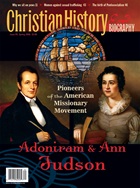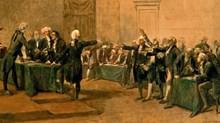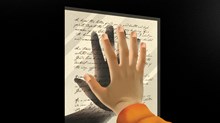In New Orleans, the saints go marching on.
Since Hurricane Katrina devastated New Orleans, a small but vibrant Roman Catholic parish has entered the public eye. As the city's Catholic hierarchy struggled to deal with widespread damage to church property, the St. Augustine parish was slated to close in March and merge with the much larger St. Peter Claver parish several blocks east. But parishioners and supporters protested. "There are people who have roots in this church who are all over the country," New Orleans resident Joan Rhodes told The Louisiana Weekly. "You shut that down and you really are putting a knife in the heart of the culture."
St. Augustine was founded in 1841 by slaves and free blacks and through the years has also welcomed Creole, Haitian, French, and Spanish worshippers. Today, one result of this unique cultural ministry has been a Sunday morning service belying "America's most segregated hour," as people of many backgrounds, races, and ages gather amidst the stained-glass saints and oil paintings of Christ to sway and clap under the leadership of one of the city's best-known clergymen, 76-year-old Fr. Jerome LeDoux. In his 15 years at St. Augustine, Fr. LeDoux has established the parish as a focal point for New Orleans culture, integrating jazz music and African drumming and dancing into the worship, blessing local jazz groups, and holding festivals and special services to commemorate musicians such as Louis Armstrong.
To the relief of many, the parishioners of St. Augustine have gained an 18-month grace period to prove the parish's viability. Whether or not St. Augustine is finally allowed to keep its autonomy, it is the determination of congregations like this that will form the Christian backbone of New Orleans's rebuilding.
A Christian museum in a post-Christian society
Is the spiritual foundation of Europe collapsing? Catholic theologian George Weigel thinks so. In a recent interview about his book The Cube and the Cathedral: Europe, America, and Politics Without God, Weigel described visiting Paris and seeing the 40-story-high white marble cube, La Grande Arche de la Defense, completed in 1989 for the 200th anniversary of the Declaration of the Rights of Man and Citizen. As he compared this colossal structure with the medieval Notre Dame Cathedral nearby, he wondered, "What culture would better create the moral foundations to sustain human rights and democracy: the culture that produced the starkly modernist, indeed rationalist, featureless, cube of the Great Arch of la Defense, or the culture that produced the gargoyles and bosses, the stained glass, and the carved stone—the 'holy unsameness'—of Notre Dame?"
However one might answer Weigel's provocative question, Europeans' growing ignorance of their historic Christian roots is having practical consequences. The "Christian I.Q." of ordinary citizens in the Netherlands has declined so sharply over the past few decades that the curators of one Dutch museum have had to shut its doors for a "Christian history overhaul." Built in the 16th century, the Catherine Convent in Utrecht was opened as a museum on June 9, 1979, with a mandate from Queen Juliana to tell the story of the nation's faith—both Protestant and Catholic. Today the convent-museum houses an unparalleled collection of artifacts, including illuminated manuscripts, ecclesiastical vestments, and paintings by Rembrandt and other famed Dutch artists.
But for several years, the permanent collection has been closed for a radical revamping. The convent's website explains: "Twenty-five years ago most people were still familiar with the most important stories from the Bible and with the associated days in the church calendar. Today, it can no longer be assumed that visitors share that knowledge, and this has consequences for the way in which the museum communicates its story to the public." The museum is scheduled to reopen on June 9, 2006.
The real birthplace of Pentecostalism
Many attending the Azusa Street Centennial in Los Angeles in April 2006 were disappointed to discover that the 1906 Pentecostal revival's historical headquarters at 312 Azusa Street is now gone. But the Azusa Street building was the Pentecostal revival's second site—and visitors can still tour the place where the revival actually started: the home of caretaker Richard Asberry and his wife Ruth, at 214 North Bonnie Brae Street.
At this house, Holiness preacher William J. Seymour first led a group of African American believers in "tarrying" for the Holy Spirit to empower them as recorded in Acts 2. Soon some began speaking in tongues, another fell—"slain in the Spirit"—to the floor, and the revival began. When the burden of the eager seekers was too much for the front porch, which collapsed, the meetings were moved to Azusa Street, launching the revival that now claims some 580 million members worldwide.
The house is open for tours on Tuesdays, Wednesdays, and Thursdays from 10-3pm. Call (323) 733-8300, x2326, for an appointment.
What's hiding in Corrie Ten Boom's house?
At the Corrie Ten Boom Museum in Haarlem, Holland, you can still see "the hiding place"—the area behind a false wall in Corrie's bedroom where Jews and others were hidden. Into this small, cramped space, accessed through a sliding door in the bottom of a linen closet, four Jews and two Dutch underground workers rushed during a Gestapo raid on February 28, 1944. After 47 hours without eating, drinking, or making a sound, the six were rescued and ferried to safe houses.
Four of the six would survive the war, but the Ten Boom family was arrested. Corrie's father, Casper, who died within ten days of his arrest, had said "it would be an honor to give my life for God's ancient people." Corrie's brother Willem and nephew Christiaan also perished, and Corrie and her sister Betsy spent the last part of ten months' imprisonment in Ravensbruck concentration camp, where they shared Jesus' love with their fellow prisoners. Betsy died, but Corrie was released because of a clerical error, and she spent the next 33 years (she lived to 91) sharing what she and Betsy had learned in Ravensbruck: "There is no pit so deep that God's love is not deeper still" and "God will enable you to forgive your enemies."
At www.corrietenboom.com, you can find photographs of the hiding place and of the Ten Booms with their "extended family" of Jews and underground workers.
Israel comes to America
From the Israel Museum in Jerusalem—the foremost collection of biblical archaeology in the world—to the Maltz Museum of Jewish heritage in Cleveland, Ohio, has come a collection of artifacts illustrating Christianity's Jewish roots and development from the time of Jesus through the 7th century. "In today's world, it is increasingly important to recognize the common roots of the Jewish and Christian faiths," said Milton Maltz, the museum's founder. "We are proud to premiere this groundbreaking exhibition, providing people throughout the region with the opportunity to explore Jewish and Christian traditions in the context of their simultaneous development in ancient Israel."
Most notably on display is one of the most important Dead Sea scrolls—the Temple scroll—newly restored and on view for the first time outside of Israel. Other artifacts include the burial ossuary of Caiaphas the High Priest and a commemorative inscription bearing the name of Pontius Pilate—the only surviving physical testimony of these two figures from the story of Christ's passion—as well as a heel bone punctured by an iron nail, the only archaeological evidence of the practice of crucifixion. Visitors can also view a full-scale reconstruction of the chancel of a Byzantine era church—complete with original altar, chancel screens, baptistery, reliquary, and pulpit, and adorned by mosaics. The "Cradle of Christianity" exhibit will be at the Maltz Museum through October 22, 2006. (See www.maltzjewishmuseum.org.)
We three kings
Admit it: We Americans sometimes wish we had figures in our history to compete with the larger-than-life kings and queens of England. When archaeologists or librarians unearth something actually touched by the monarchs of old, we take notice.
Henry's weddings: Recently, a car park at the Royal Hospital in Greenwich, south London, yielded up the chapel of a palace in which Henry VIII married two of his wives, Catherine of Aragon and Anne of Cleves. Believed long destroyed, the palace was Henry's birthplace. Though the chapel is not intact, its altar and elaborately tile-bordered floor remain.
James's Bible: A King James Bible—perhaps "the" King James Bible—was discovered this winter at the University of Manitoba, Canada. Typographical idiosyncrasies proved that this was one of 50 surviving first-print copies published in 1611. Even more intriguing, it contains a card saying that it was once King James I's personal Bible. University officials hope the papers of the Bible's 19th-century donor, Rev. Daniel Greatorex, will contain the evidence needed to substantiate this claim.
Edward's tomb: A third find brings the year 1066 a little closer: the original tomb of King Edward the Confessor, who was known for his piety and reputed to have the gift of divine healing. This vaulted stone chamber lies right where records said it was, on the central axis of Westminster Abbey in front of the site of the church's original High Altar. Edward's remains are in another, known location, having been moved twice in the 12th and 13th centuries. Edward's death in 1066, and his succession by Harold Godwinson, sparked the Norman invasion.
Copyright © 2006 by the author or Christianity Today/Christian History & Biography magazine.
Click here for reprint information on Christian History & Biography.

Support Our Work
Subscribe to CT for less than $4.25/month





























